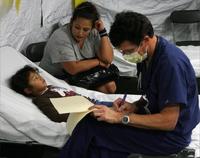Report: Hospitals could handle pandemic
October 5, 2009
A new report suggests that Texas would have sufficient hospital beds if 35 percent of its residents fall ill during the swine flu pandemic this fall, but the state has only enough antiviral medicines to prevent or treat flu in 20 to 25 percent of its population.
Written by Mary Ann Roser, Austin-American Statesman

Three year-old Royanna Ayala, with her mother, Sarah, was examined by Dr. Scott Nowlin in one of the triage tents at Dell Children's Medical Center on Thursday. The vast majority of the patients coming to emergency rooms for flu are not being hospitalized, doctors at area hospitals said. Texas is expected to have enough hospital beds in the event of a mild H1N1 pandemic.
A new report suggests that Texas would have sufficient hospital beds if 35 percent of its residents fall ill during the swine flu pandemic this fall, but the state has only enough antiviral medicines to prevent or treat flu in 20 to 25 percent of its population.
The report by the Trust for America's Health, a Washington-based nonprofit, said it based the projections on a relatively mild pandemic using calculations from the U.S. Centers for Disease Control and Prevention.
The CDC's FluSurge model estimates that 8.5 million Texans would get the H1N1 virus, or swine flu, and that 105,287 might need to be hospitalized this fall. This would cause 66 percent of the state's hospital beds to be filled during the height of the outbreak, the report says.
Texas has about 80,000 hospital beds, according to the Texas Hospital Association.
Austin-area hospital and health officials said they have been planning for the pandemic for years and feel well-prepared. Dell Children's Medical Center has set up tents and has been handling double the usual number of emergency room visits per day for about two weeks.
Fifteen states would be at capacity or would run out of hospital beds, the report says.
Swine flu is widespread in Texas, but it has caused mild to moderate illness.
Texas is one of 11 states that has only enough antiviral medicines, such as Tamiflu, to cover 20 to 25 percent of its population. That could be a problem if there are a lot of sick people with underlying health conditions that make them at risk for complications from flu, the report says.
"Our point is not to cry chicken little but to point out the potential a mild pandemic can have," said Jeffrey Levi, executive director of the Trust for America's Health.
He said he's concerned that cuts to local health departments could weaken their ability to respond to the pandemic. They have lost 8,000 staff positions in the first half of this year on top of 7,000 jobs lost in 2008, the report says. Money also has been cut.
He added that public education was important to not overload the system. "The situation may not be as dire as it seems if we can get vaccine to people as quickly as possible," he said.
The H1N1 vaccine will be coming in to states more slowly than expected, and Texas will get just half of the 3.4 million doses it anticipated by Oct. 15, state officials have said.
As for antivirals, the CDC said that on Thursday, Texas received 22,000 liquid courses of Tamiflu for children. The state is "working out the details for distributing" it to clinics that serve the needy and to pharmacies, said Doug McBride, a state Health Services department spokesman.
![]()
![]()
Related Stories
![]()
Fair Use Notice
This site contains copyrighted material the use of which has not always been specifically authorized by the copyright owner. We are making such material available in our efforts to advance understanding of environmental, political, human rights, economic, democracy, scientific, and social justice issues, etc. We believe this constitutes a "fair use" of any such copyrighted material as provided for in section 107 of the US Copyright Law. In accordance with Title 17 U.S.C. Section 107, the material on this site is distributed without profit to those who have expressed a prior interest in receiving the included information for research and educational purposes. For more information go to: http://www.law.cornell.edu/uscode/17/107.shtml. If you wish to use copyrighted material from this site for purposes of your own that go beyond "fair use", you must obtain permission from the copyright owner.